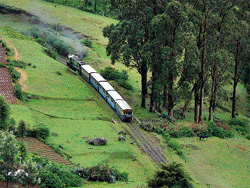Scenic Ride
Few trains offer the type of excitement that the Nilgiri Mountain Railway (NMR) does. The leisurely journey it takes is best suited for nature lovers, as it offers a view of the mountain flora, and life in the hill at close quarters.
It was the British who, in the year 1908, planned and built the railway line, in order to reach hill stations such as Coonoor and Ooty. The NMR covers a distance of 41.8 km between Mettupalayam and Ooty, at an altitude of 2600 m, spanning 208 curves, 250 bridges, and 16 tunnels. It has a unique narrow gauge of 1,000 mm and rack pinion arrangement to negotiate the climbs and steep descents. It has one of the steepest gradients to climb during its journey.
The once popular steam locomotives have now been replaced by diesel engines between Ooty and Coonoor. The upward journey takes about five hours while the descent takes about four hours. A daily passenger train runs between Mettupalayam and Ooty.
However, four shuttle trains ply daily between Ooty and Coonoor and back.
In 2005, UNESCO designated NMR as a World Heritage Site, as part of the Mountain Railways of India. The NMR has hosted the filming of a few Indian as well foreign films.
The NMR is an engineering marvel, which must have been tough to build on a difficult terrain a century ago. It is still a challenge to run the train during rainy months.
I was impressed by the fact that tickets are issued as per the capacity of the compartment, with no standees allowed. However, if seats are available in the reserved coaches, then these are filled up at a higher rate, that includes reservation charges. The large windows facilitate easy viewing of the passing scenery of verdant forests, hills, dales, towns and villages. Tea estates fill up the gentle hill slopes. We pass through quaint stations with romantic names like Arvunkadu, Lovedale, Glendale and Wellington.
The diesel engine hoots constantly to keep away stray animals and people who might be caught unawares by the rushing train, though at 10.4 kmph, it might be the slowest in the country!
The manner in which the driver and the station staff communicate might appear amusing in this day of technological advancement. If there is a problem, such as a failed signal, the only way around it is to send a messenger on foot to the stranded train with a note stating that the driver is authorised to drive the train to the station.
source: http://www.DeccanHerald.com / Home> Supplements> Sunday Herald Travel / by DBN Murthy / October 06th, 2012
